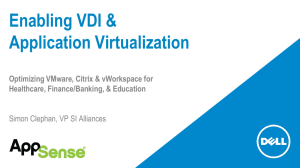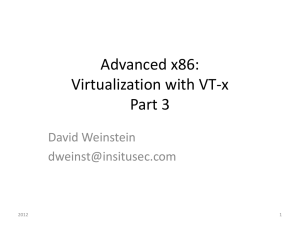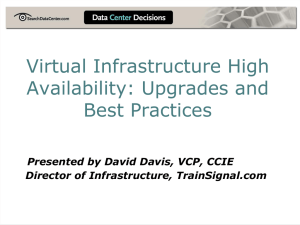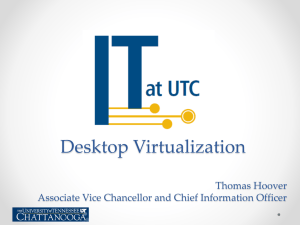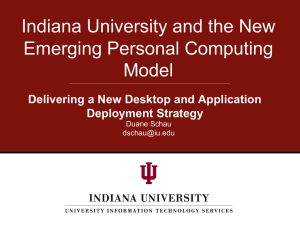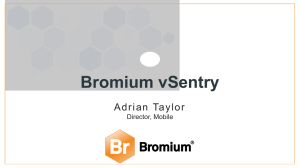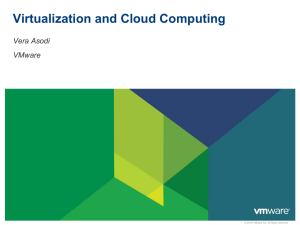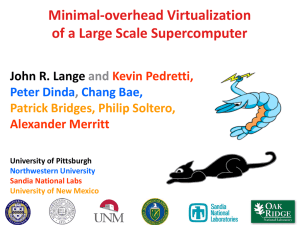Virtualization Techniques
advertisement
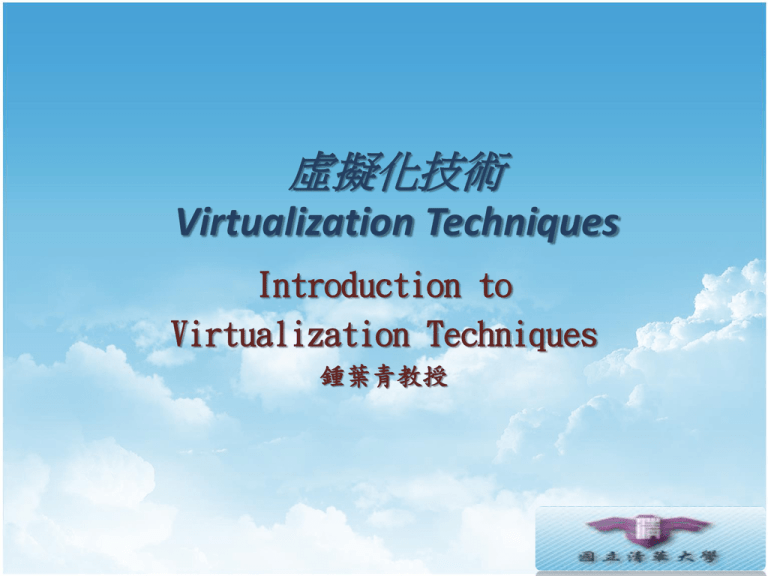
虛擬化技術 Virtualization Techniques Introduction to Virtualization Techniques 鍾葉青教授 Agenda • Overview Virtualization Introduction • Virtualization Techniques System Virtualization Storage Virtualization Network Virtualization GPU Virtualization Software Virtualization Hardware Support Virtualization Definition of Virtualization In computing, virtualization means to create a virtual version of a device or resource, such as a server, storage device, network or even an operating system where the framework divides the resource into one or more execution environments. Multiple VMs in One Machine Performance of Virtualizations History of Virtualization Traditional-virtualization 1964 IBM CP-40 1972 IBM VM/370 Mainframe Virtualization Time Sharing Virtual Memory 1997 Virtual PC Para-virtualization HW-assist 1999 VMware Desktop Virtualization 2003 Xen Server Virtualization 2005 Intel VT 2006 AMD VT Cloud Computing Mobile Virtualization 2007 KVM-X86 2012 Xen-ARM KVMARM Example: Server Virtualization http://www.energystar.gov/index.cfm?c=power_mgt.datacenter_efficiency_virtualization Benefits of Server Virtualization • Virtualization can reduce data center energy expenses by 10%–40% • Virtualization also improves scalability, reduces downtime, and enables faster deployments. • Reduce the data center footprint Example: Mobile Virtualization Gartner predict that by 2012, more than 50% of new smart phones shipped will be virtualized VMware MVP ARM Cortex-A15 enables efficient handling of the complex software environments including full hardware virtualization Benefits of Mobile Virtualization • • • • • • • Portability Multiple OSes on a single chip Security Dynamic Update of System Software Legacy Code re-use IP Protection Mobile Manageability Linux RTOS Embedded Hypervisor P1 P2 multiple operating systems Linux Security Embedded Hypervisor P1 P2 security environment Reference : http://en.wikipedia.org/wiki/Embedded_Hypervisor Virtualization Techniques (1/2) • System Virtualization CPU Virtualization Memory Virtualization I/O Virtualization • Storage Virtualization LVM RAID • Network Virtualization Software Defined Network Open vSwitch InfiniBand Virtualization Virtualization Techniques (2/2) • GPU Virtualization • Software Virtualization Virtual Desktop Infrastructure (VDI) EyeOS • Hardware Support Virtualization Intel VT ARM SRIOV MRIOV System Virtualization Storage Virtualization Network Virtualization GPU Virtualization Software Virtualization Hardware Support Virtualization VIRTUALIZATION TECHNIQUES Virtual Machine (1/2) • A virtual machine (VM) is a software implementation of a machine that executes programs like a physical machine. Virtual machines are separated into two major classifications: A system virtual machine • Which provides a complete system platform which supports the execution of a complete operating system (OS) A process virtual machine • Which is designed to run a single program, which means that it supports a single process. Virtual Machine (2/2) Guest Applications Guest Operating System Java Program System VM Process VM VMware Java Virtual Machine This course we will focus on the system virtualization System Virtual Machine • System virtual machine is controlled by a hypervisor or VMM (Virtual Machine Monitor) • A hypervisor or VMM is a software to provide a hardware emulation interface including CPU, memory, I/O by multiplexing host resources Two Types of Hypervisor (1/2) • In their 1974 article "Formal Requirements for Virtualizable Third Generation Architectures" Gerald J. Popek and Robert P. Goldberg classified two types of hypervisor: Type 1 hypervisor : bare metal type Type 2 hypervisor : hosted type Two Types of Hypervisor (2/2) Type 1 (or native, bare metal) hypervisors Type 2 (or hosted) hypervisors http://en.wikipedia.org/wiki/Hypervisor Purposes of Hypervisor • CPU Virtualization Handle all sensitive instructions by emulation • Memory Virtualization Allocate guest physical memory Translate guest virtual address to host virtual address • I/O Virtualization Emulate I/O devices for guest Ex: Keyboard, UART, Storage and Network Implementations of Hypervisor • Full Virtualization A wholly emulated virtual machine makes guest operating system binary can be executed directly without modifying guest source code For efficiency, it needs hardware-assisted virtualization • Para-Virtualization Hypercalls are defined and used in a guest operating system to make a virtual machine abstraction According to literature, it’s most efficient way • Pre-Virtualization By compiling technique, guest operating system binary or source could be compiled for virtualization Hypervisor Case: KVM QEMU VM 0 I/O Virtualization Hypervisor Linux + KVM CPU Virtualization Hardware 1. 2. 3. 4. CPU MMU VM 1 MMU Virtualization Timer I/O Interrupt CPU and memory virtualizations are handled in the Linux Kernel Space I/O virtualization is handled in the Linux User Space by QEMU It’s a type 2 virtual machine It’s a full virtualization implementation System Virtualization Storage Virtualization Network Virtualization GPU Virtualization Software Virtualization Hardware Support Virtualization VIRTUALIZATION TECHNIQUES LVM(1/2) Logical Volume Manager • LVM is a logical volume manager for the Linux kernel; it manages disk drives and similar mass-storage devices. LVM(2/2) : Example • Disk partition -> physical volumes -> volume group -> logical volumes -> file systems RAID • RAID (redundant array of independent disks) is a storage technology that combines multiple disk drive components into a logical unit. • Data is distributed across the drives in one of several ways called "RAID levels“, such as RAID0, RAID1, etc., depending on the level of redundancy and performance required. Example : RAID 0 and RAID 1 It provides improved performance and additional storage but no fault tolerance (block-level striping without parity or mirroring) . mirroring without parity or striping LVM and RIAD for Virtualization • LVM provides a virtual storage systems which is flexible to partition and allocate logical volumes to virtual machines • RAID not only improves storage performance but has fault tolerance capability • Leaning how to configure LVM and RAID in the virtualization system System Virtualization Storage Virtualization Network Virtualization GPU Virtualization Software Virtualization Hardware Support Virtualization VIRTUALIZATION TECHNIQUES Software Defined Network (1/2) • Software defined networking (SDN) is an approach to building computer networks that separates and abstracts elements of these systems • SDN decouples the system that makes decisions about where traffic is sent (the control plane) from the underlying system that forwards traffic to the selected destination (the data plane) Software Defined Network (2/2) • The inventors and vendors of these systems claim that this technology simplifies networking and enables new applications, such as network virtualization in which the control plane is separated from the data plane and implemented in a software application. Open vSwitch (1/2) • Open vSwitch is a flexible, multi-layer software network switch. Typically used in virtualization environments as the network switching component in the hypervisor. • Open vSwitch maintains the logical state of a virtual machine's network connection across physical hosts when a virtual machine is migrated, and it can be managed and monitored by standard protocols such as: OpenFlow, NetFlow, sFlow, SPAN, RSPAN. Open vSwitch (2/2) • When it comes to virtualization, open vSwitch is attractive because it provides the ability for a single controller to manage your virtual network across all your servers. InfiniBand Virtualization • InfiniBand is a switched fabric communications link used in high-performance computing and enterprise data centers. • It has two key features : low latency and high bandwidth • Virtualization Using InfiniBand Brings Big Benefits to Data Centers System Virtualization Storage Virtualization Network Virtualization GPU Virtualization Software Virtualization Hardware Support Virtualization VIRTUALIZATION TECHNIQUES What’s GPU (Graphics processing unit) • A Graphics Processing Units (GPUs) are highperformance many-core processors capable of very high computation and data throughput. Performance Comparison: GPU vs. CPU • While the Intel Core I7 980X (extreme edition) gives us around 110GFLOPS, GPUs such as AMD Radeon 6970 and NVidia C2090 offer more than 660GFLOPS. GPGPU • High performance of modern Graphics Processing Units may be utilized not only for graphics related application but also for general computing. • Today’s GPUs are general-purpose parallel processors with support for accessible programming interfaces and industry-standard languages such as C. • Developers who port their applications to GPUs often achieve speedups of orders of magnitude vs. optimized CPU implementations. GPU Virtualizatio • GPU virtualization allows multiple virtual machines to interact directly with a GPU and manages the GPU resources so multiple users can share common hardware, while improving user density. System Virtualization Storage Virtualization Network Virtualization GPU Virtualization Software Virtualization Hardware Support Virtualization VIRTUALIZATION TECHNIQUES Software Virtualization • IT administrators have a lot to deal with in today’s corporate infrastructure. With the ever increasing prices of upgrading desktop computers, software virtualization is becoming very appealing. • It has following features: Ease of Management Security Green Portable Virtual Desktop Infrastructure (VDI) • Virtual desktop Infrastructure (VDI) is a desktop-centric service that hosts users desktop environments on remote servers, which are accessed over a network using a remote display protocol. EyeOS : Web Desktop Virtualization • eyeOS is a web desktop following the cloud computing concept that seeks to enable collaboration and communication among users. It is mainly written in PHP, XML, and JavaScript System Virtualization Storage Virtualization Network Virtualization GPU Virtualization Software Virtualization Hardware Support Virtualization VIRTUALIZATION TECHNIQUES Intel VT-x • New CPU Operating Mode VMX Root Operation Non-Root Operation • New Transitions VM entry to Guest VM exit to VMM • VM Control Structure Configured by VMM software ARM Virtualization Extension • • Secure world supports a single virtual machine New Non-secure level of privilege to hold Hypervisor • Hypervisor mode applies to normal world Hyp Mode is used by the Hypervisor Guest OS given same kernel/user privilege structure as for a non virtualized environment Monitor mode controls transition between worlds Single-Root I/O Virtualization • PCI-SIG specifies multiple functional elements addressing performance and security aspects of I/O virtualization • PCIe devices will have multiple virtual functions (VF’s) Multi-Root I/O Virtualization • Multiple hardware domains utilizing same IO endpoints • Virtual functions are dedicated to virtual machines

